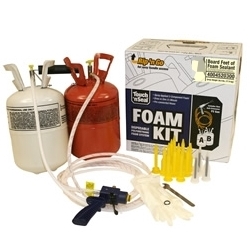
Applying spray foam insulation to ceilings and walls is one of the best ways to insulate against drafts and outside air during extreme weather months, especially in rooms such as the attic and basement.
Sealing up the cracks and gaps in these rooms with spray foam insulation helps reduce the amount of energy used to heat and cool the home, as well as the amount of money spent on doing so.
Closed cell and open cell Touch N Seal foam are two types of spray foam insulation that can be used for insulating these rooms.
The easiest way to think of foam is to think of it like whipped cream in a can. Two components are involved, the cream and the air.
If you increased the amount of air in the product by 10x, you would get a lot more coverage, but it would be a lot less dense. And since air is free, you’re paying less per ounce.
If you decreased the amount of air by 10x, you could cover less space, but it would be denser. And since there’s less air, you’re paying more per ounce.
With foam, the denser the product, the less water it can absorb.
Closed cell foam is more expensive, it expands about 30 times the liquid volume, it has a higher R-value, and it doesn’t absorb water readily.
Closed cell Touch N Seal foam gets its name because the foam cells are packed together and closed. The strength and density of this foam allow it to be resistant to water absorption. Additional important details about closed cell foam include:
- Expansion: up to 30 times when applied at 1″ thick
- Density: 1.75 +/- 0.2 pounds per cubic feet
- R-Value: 7.12 per inch
In contrast, the cells in open cell foam are not closed completely or packed close together, and this type of foam readily absorbs water. Keep in mind these important details about open cell foam when deciding which type you need:
- Expansion: 100 times the liquid volume
- Density: 0.4 to 0.5 pounds per cubic feet
- R-Value: 3.5 per inch
Closed cell and open cell Touch N Seal foam are different in a number of ways. While open cell foam typically costs less, the strength, density, and higher R-Value of closed cell foam makes it the more advantageous of the two.
